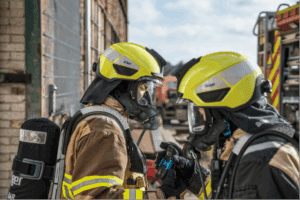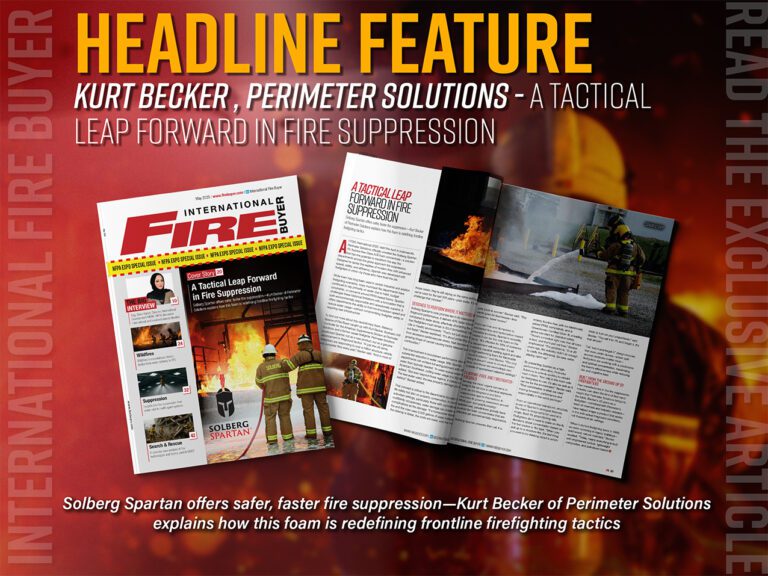Rebecca Spayne, Managing Editor for Fire Buyer magazine catches up with Pete Hancox, UK Country Manager at Allegion, to discuss the latest developments in fire door safety
Allegion UK specialises in mechanical hardware solutions, producing high quality, highly engineered door hardware designed to endure constant use in busy environments across the world. With over 100 years of industry knowledge and understanding, Allegion UK has assembled a house of reputable brands, offering everything from door closers and exit devices to door furniture and residential and commercial locks.
As experts in the industry, Allegion recognises that architectural ironmongery plays a critical role in the safety and security of the built environment and remain committed to raising awareness on the importance of correctly specified, installed and maintained fire door hardware.
In this Innovator interview, International Fire Buyer sits down exclusively with Head of UK operations at Allegion, Pete Hancox to find out more about the innovations in fire doors and their importance to fire safety.
Could you please introduce yourself and provide an overview of Allegion’s role in the market?
My name is Pete Hancox and I have worked in the door and door hardware industry for almost 20 years, holding a number of commercial and operations positions. I’m now responsible for the UK region as Country Manager at Allegion UK.
We have seen a number of regulatory reforms recently, such as the Fire Safety Act 2021 and Building Safety Bill, what does this mean to stakeholders?
We’re facing a continuous, industry-wide challenge to improve fire safety within UK buildings. Between schools and hospitals to high-rise residential structures and industrial facilities, fire safety remains the highest importance for any category of building – because when it comes to fire, there are simply no exemptions.
Following the Government’s building safety reform and the ground-breaking Grenfell Tower Inquiry, the introduction of regulatory reforms has validated proportionate fire safety standards in high-rise and other multi-occupied residential buildings. The Fire Safety Act 2021, which amends the Regulatory Reform (Fire Safety) Order 2005, impacts multiple touchpoints in the built environment and warns stakeholders of the importance of watertight processes. The new regulation has had a significant impression on duty holders in multi-occupied high-rise buildings – from the architects who draw up the plans right through to the developers who build them, and then finally the landlords and building owners who are responsible for maintaining a safe and compliant environment for residents and occupiers upon completion.
Equally, the Building Safety Bill has had an impact on stakeholders, but instead grants residents and homeowners more rights, powers and protection to hold builders and developers to account by introducing tougher sanctions against those who neglect safety. Most recently, we’ve seen Government published guidance that explains the roles and requirements of Responsible Persons in all non-domestic premises, with changes being a result of the Fire Safety Order alterations through the Building Safety Act 2022.
There’s been a significant overhaul in how responsible persons must approach fire safety in recent years, but in a nutshell, the reforms have been put in place to improve fire safety standards as a whole, and all with an aim to make residents, occupants and visitors feel safer within the buildings they live, work and play.
The six-year anniversary for the Grenfell Tragedy has just taken place, how has this disaster revolutionised passive fire protection in the built environment?
There’s no doubt that Grenfell was a catalyst for change. Ever since, we’ve seen the incremental introduction of new reforms (such as the Fire Safety Act 2021 and Building Safety Act 2023), alongside major government funding schemes, with both playing strategic roles in raising fire safety standards across the board.
Once an afterthought, fire safety has been brought to the forefront of the media and people’s minds. But despite significant steps being made, there is still a level of uncertainty and misconception towards passive fire protection and fire door safety.
Fire safety legislation and guidance has now moved on and continues to change (from 1st October 2023, new guidance will be coming into force, forming Phase 3 of the Home Office’s fire safety reform programme). With that said, if we are to further improve cooperation, coordination and compliance, there’s an onus on all decision makers and responsible persons to keep informed and stay on track.
Have you seen a keener interest from your customers about acquiring the highest calibre products to ensure safety and competency?
As a manufacturer, we’ve found that partners throughout the supply chain are more readily reaching out for expert advice on all areas of door hardware selection, installation and maintenance. Allegion products are an integral part of the door system and as such, we work hard to ensure our customers have access to the information they need concerning fire door performance and product traceability when specifying or purchasing Briton fire door hardware.
More than ever, there’s a demand for higher product standards and we believe each touch point should possess a golden thread of detail for traceability and peace of mind. Allegion welcomes notified bodies and supporting industry bodies that are lobbying for change, right the way through the manufacturing of the door system to the components and installation process. The Construction Products Association (CPA) continues to develop its accredited scheme – the Code of Construction Product Information (CCPI) – which provides customers with transparent and accurate product information, which is driving for higher standards in the industry.
What are the responsibilities of decision makers or the responsible person?
Ultimately, everyone has a role to play when it comes to fire safety. More specifically, the Fire Safety Order places the duty of fire safety protection upon a building’s responsible person. All designated responsible persons must provide an in-depth, transparent overview of their building’s condition while ensuring all necessary steps have been followed to reduce the risk of fire.
As part of their obligations, a responsible person is required to possess robust knowledge of fire safety, manage ongoing risk assessments and be familiar with The Fire Safety Act 2021. We urge all responsible persons to review their responsibilities under new fire safety legislation – which includes conducting regular fire door hardware checks to help identify potential fire hazards in their building – and if faced with any uncertainty throughout the process, seek professional advice…
To read the full article, see our last issue here.
Never miss a story… Follow us on:
International Fire Buyer
@Firebuyer
Fire Buyer
Media Contact
Rebecca Spayne Managing Editor, International Fire Buyer
Tel: +44 (0) 1622 823 920
Email: [email protected]




































